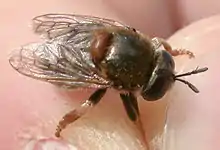Microdon mutabilis
Microdon mutabilis, is a species of hoverfly. It is found in many parts of Britain and Europe. The distinctive almost slug-like larvae live in ants' nests. They are hemispherical in shape, heavily armoured and believed to prey on the eggs and larvae of a number of ant species, including Formica lemani, Formica fusca, Lasius niger and Myrmica ruginodis.[1] It was described by Carl Linnaeus in his landmark 1758 10th edition of Systema Naturae.[2]
| Microdon mutabilis | |
|---|---|
 | |
| Scientific classification | |
| Kingdom: | |
| Phylum: | |
| Class: | |
| Order: | |
| Family: | |
| Genus: | |
| Species: | M. mutabilis |
| Binomial name | |
| Microdon mutabilis | |
| Synonyms | |
| |
Description
Wing length 6–9 mm. Pterostigma 2-2.5 times as long as the length of the wing margin between ends of wing veins R1 and R2+3. Scutellum red or dark red. The male genitalia are figured by Doczkal and Schmid (1999).[3] Note M. mutabilis is only reliably distinguished from M. myrmicae by features of the puparium. See references for determination.[4][5] [6][7][8]
References
- Stubbs, Alan E. & Falk, Steven J. (1983). British Hoverflies: An Illustrated Identification Guide. British Entomological & Natural History Society. pp. 253, xvpp.
- "Microdon mutabilis (Linnaeus, 1758)". Global Biodiversity Information Facility. Retrieved 11 December 2018.
- Doczkal, D. & Schmid, U. (1999). "Revision der mitteleuropäischen Arten der Gattung Microdon Meigen (Diptera, Syrphidae)". Volucella. 4: 45-68.
- Van Veen, M. (2004) Hoverflies of Northwest Europe: Identification Keys to the Syrphidae. 256pp. KNNV Publishing, Utrecht.addendum
- Van der Goot, V. S. (1981). De zweefvliegen van Noordwest - Europa en Europees Rusland, in het bijzonder van de Benelux. KNNV, Uitgave no.32: 275pp. Amsterdam.
- Bei-Bienko, G. Y. & Steyskal, G. C. (1988). Keys to the Insects of the European Part of the USSR, Volume V: Diptera and Siphonaptera, Part I. Amerind Publishing Co., New Delhi. ISBN 81-205-0080-6
- Coe, R. L. (1953). "Diptera: Syrphidae". Handbooks for the Identification of British Insects. 10 (1): 1-98. Royal Entomological Society.
- Speight, M. C. D. (2011). "Species accounts of European Syrphidae (Diptera)" (PDF). Syrph the Net, the database of European Syrphidae. 65: 285pp.
External links
- "Taxonomy Browser: Microdon mutabilis". Barcode of Life Data System (BOLD). Retrieved July 12, 2020. With images.